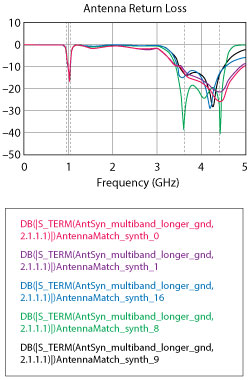NI AWR Group, El Segundo, Calif.
The NI AWR Design Environment platform was conceived and developed with RF designers in mind, empowering the individual engineer and engineering teams to address all phases of the design process (exploration, simulation, optimization and verification) prior to manufacturing, while also providing a smooth transition to fabrication and test, with minimal design rework.
Microwave Office circuit design software was introduced 20 years ago at IMS1998 in Baltimore, with a Windows-based user interface and a real-time tuning bar (see Figure 10) that caught the attention of many attendees, putting AWR and its product on the map. From its inception, the overall framework of the software was architected to readily support third-party tools and technologies, to supplement product functionality and offer designers power of choice, as well as maximum flexibility and productivity.

Figure 10 Parametric tuning introduced in Microwave Office software in 1998 has evolved to support large-scale tuning of complex structures.
The NI AWR software platform has expanded to offer more innovations such as AXIEM and Analyst™ native EM solvers, Visual System Simulator™ system simulation software and AntSyn™ antenna synthesis technology, as well as wizard-based features and third-party add-ons that further enhance RF designers’ productivity.
The NI AWR Design Environment user interface is a Windows-based, PC-only platform that has always leveraged application programming interfaces (API) and object-oriented programming with a unique underlying unified data model architecture that links electrical and physical design in a revolutionary way. A change to one is instantly a change to the other and vice-versa, eliminating the manual manipulation required with alternative tools.

Figure 11 Network synthesis addresses multi-band matching challenges.
The environment’s framework is further constructed as a socket for ready plug-and-play of tools and technologies that can be native or from third-party partners. For instance, the EM Socket™ interface within the NI AWR Design Environment platform integrates AXIEM 3D planar and Analyst 3D EM solvers, as well as those from other EM vendors such as Sonnet, SIMULIA CST and ANSYS. Numerous other wizards and add-on modules, whether developed in house or by partner firms, will “socket” into the NI AWR software framework to further enhance engineering productivity.
The high frequency circuit, system and EM capabilities of NI AWR Design Environment software address the key design steps of RF/microwave product development, from characterization and simulation to exploration, optimization, compliance and verification, always mindful of the software team’s mantra to “accelerate customer design success.”
One of the next fronts of innovation for the platform is accelerating design starts and exploration via synthesis technologies and techniques. A new network synthesis capability for creating optimized two-port matching networks with discrete and distributed components, based on user-defined performance goals, is being introduced this year (see Figure 11). The proprietary synthesis algorithm searches for the best circuit typologies and optimizes the component parameter values. This feature joins existing synthesis tools within the NI AWR portfolio that include products such as iFilter™ filter synthesis and AntSyn automated antenna design, synthesis and optimization.
The new-to-market synthesis tool will assist RF design engineers in developing new products directly from performance specifications, greatly accelerating the earliest phases of the design process. The first release of this new module, available as an add-on to the V14 release, will be particularly helpful for challenging broadband single- and multi-stage amplifiers and antenna/amplifier matching networks.

